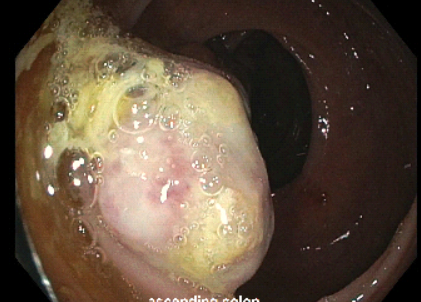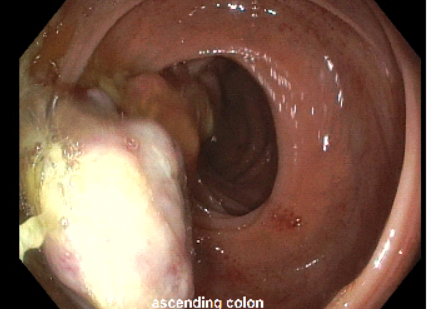Sunday Poster Session
Category: IBD
P1226 - An Ileocecal Valve Mass: A Rare Presentation of Crohn's Disease
Sunday, October 26, 2025
3:30 PM - 7:00 PM PDT
Location: Exhibit Hall
- ZK
Zach Kovach, MD
West Virginia University School of Medicine
Morgantown, WV
Presenting Author(s)
Katherine Shepherd, MD, Rehmat Awan, MD, Zach Kovach, MD, Kanwarpreet Tandon, MBBS, Jennifer Hadam-Veverka, MD
West Virginia University School of Medicine, Morgantown, WV
Introduction: Crohn's disease (CD) is an inflammatory condition which can involve the entire gastrointestinal tract. While CD is typically diagnosed in younger adults aged 20-30, a bimodal distribution exists where 10-15% of adults are diagnosed over the age of 60. CD has a wide presentation of symptoms including diarrhea, hematochezia, weight loss, fatigue, and abdominal pain. We present an ileocecal mass discovered during screening colonoscopy as a rare presentation of CD.
Case Description/
Methods: A 64-year-old female with a past medical history of frontal lobe anaplastic astrocytoma and seizures presented for a screening colonoscopy revealing a large, ulcerated mass extending from ileocecal valve into the ascending colon concerning for malignancy (Figure 1 and 2). Biopsies were negative for malignancy, but showed ulceration and granulation tissue with a few benign colonic fragments with crypt distortion. Carcinoembryonic antigen was normal and computed tomography of the chest, abdomen, and pelvis demonstrated marked edema of terminal ileum with adjacent inflammatory changes and intraluminal filling defect within the cecum. Given concern for underlying invasive adenocarcinoma, she was referred for surgical evaluation as the mass was unresectable via endoscopic approach. She underwent a right hemicolectomy. Postoperative pathology of the terminal ileum and right colon revealed inflammatory polyp of the ileocecal valve overlying transmural inflammation consistent with CD without dysplasia or carcinoma. Upon further questioning, the patient reported 6 months of diarrhea with nocturnal symptoms along with a new diagnosis of psoriasis behind her ears. Postoperatively, she continued to have diarrhea. After a risk/benefit discussion, she was started on adalimumab to reduce the risk of post-operative recurrence. She was in clinical remission and follow up endoscopy verified endoscopic remission.
Discussion: We present an ileocecal valve mass as an extraordinarily rare presentation of CD. While inflammatory polyps have been noted in CD, they are rarely present at initial diagnosis. This case underscores the importance of obtaining a detailed history of past and present symptoms, as the patient's change in bowel habits was not discovered until after the hemicolectomy and diagnosis of CD was established. Colonic masses are always suspicious for malignancy, however this case highlights the importance in maintaining a broad differential due to unpredictable and often unique presentations of inflammatory bowel disease.

Figure: Figure 1: Endoscopic visualization of colonic mass

Figure: Figure 1: Endoscopic visualization of colonic mass extending into ascending colon
Disclosures:
Katherine Shepherd indicated no relevant financial relationships.
Rehmat Awan indicated no relevant financial relationships.
Zach Kovach indicated no relevant financial relationships.
Kanwarpreet Tandon indicated no relevant financial relationships.
Jennifer Hadam-Veverka: Abbvie – Speakers Bureau. Johnson & Johnson – Speakers Bureau. Takeda – Speakers Bureau.
Katherine Shepherd, MD, Rehmat Awan, MD, Zach Kovach, MD, Kanwarpreet Tandon, MBBS, Jennifer Hadam-Veverka, MD. P1226 - An Ileocecal Valve Mass: A Rare Presentation of Crohn's Disease, ACG 2025 Annual Scientific Meeting Abstracts. Phoenix, AZ: American College of Gastroenterology.
West Virginia University School of Medicine, Morgantown, WV
Introduction: Crohn's disease (CD) is an inflammatory condition which can involve the entire gastrointestinal tract. While CD is typically diagnosed in younger adults aged 20-30, a bimodal distribution exists where 10-15% of adults are diagnosed over the age of 60. CD has a wide presentation of symptoms including diarrhea, hematochezia, weight loss, fatigue, and abdominal pain. We present an ileocecal mass discovered during screening colonoscopy as a rare presentation of CD.
Case Description/
Methods: A 64-year-old female with a past medical history of frontal lobe anaplastic astrocytoma and seizures presented for a screening colonoscopy revealing a large, ulcerated mass extending from ileocecal valve into the ascending colon concerning for malignancy (Figure 1 and 2). Biopsies were negative for malignancy, but showed ulceration and granulation tissue with a few benign colonic fragments with crypt distortion. Carcinoembryonic antigen was normal and computed tomography of the chest, abdomen, and pelvis demonstrated marked edema of terminal ileum with adjacent inflammatory changes and intraluminal filling defect within the cecum. Given concern for underlying invasive adenocarcinoma, she was referred for surgical evaluation as the mass was unresectable via endoscopic approach. She underwent a right hemicolectomy. Postoperative pathology of the terminal ileum and right colon revealed inflammatory polyp of the ileocecal valve overlying transmural inflammation consistent with CD without dysplasia or carcinoma. Upon further questioning, the patient reported 6 months of diarrhea with nocturnal symptoms along with a new diagnosis of psoriasis behind her ears. Postoperatively, she continued to have diarrhea. After a risk/benefit discussion, she was started on adalimumab to reduce the risk of post-operative recurrence. She was in clinical remission and follow up endoscopy verified endoscopic remission.
Discussion: We present an ileocecal valve mass as an extraordinarily rare presentation of CD. While inflammatory polyps have been noted in CD, they are rarely present at initial diagnosis. This case underscores the importance of obtaining a detailed history of past and present symptoms, as the patient's change in bowel habits was not discovered until after the hemicolectomy and diagnosis of CD was established. Colonic masses are always suspicious for malignancy, however this case highlights the importance in maintaining a broad differential due to unpredictable and often unique presentations of inflammatory bowel disease.

Figure: Figure 1: Endoscopic visualization of colonic mass

Figure: Figure 1: Endoscopic visualization of colonic mass extending into ascending colon
Disclosures:
Katherine Shepherd indicated no relevant financial relationships.
Rehmat Awan indicated no relevant financial relationships.
Zach Kovach indicated no relevant financial relationships.
Kanwarpreet Tandon indicated no relevant financial relationships.
Jennifer Hadam-Veverka: Abbvie – Speakers Bureau. Johnson & Johnson – Speakers Bureau. Takeda – Speakers Bureau.
Katherine Shepherd, MD, Rehmat Awan, MD, Zach Kovach, MD, Kanwarpreet Tandon, MBBS, Jennifer Hadam-Veverka, MD. P1226 - An Ileocecal Valve Mass: A Rare Presentation of Crohn's Disease, ACG 2025 Annual Scientific Meeting Abstracts. Phoenix, AZ: American College of Gastroenterology.
